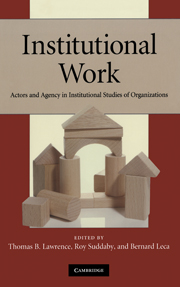1 - Introduction: theorizing and studying institutional work
Published online by Cambridge University Press: 15 September 2009
Summary
The concept of institutional work describes “the purposive action of individuals and organizations aimed at creating, maintaining and disrupting institutions” (Lawrence & Suddaby, 2006: 215). Institutional work represents an exciting direction for institutional studies of organization, not because it represents a “new” idea, but because it connects a set of previously disparate ideas, and in doing so points to new questions and opens up space for new conversations. Institutional approaches to organization theory have traditionally focused attention on the relationships among organizations and the fields in which they operate, providing strong accounts of the processes through which institutions govern action. The study of institutional work reorients these traditional concerns, shifting the focus to understanding how action affects institutions. Connecting, bridging, and extending work on institutional entrepreneurship, institutional change and innovation, and deinstitutionalization, the study of institutional work is concerned with the practical actions through which institutions are created, maintained, and disrupted. The concept of institutional work highlights the intentional actions taken in relation to institutions, some highly visible and dramatic, as often illustrated in research on institutional entrepreneurship, but much of it nearly invisible and often mundane, as in the day-to-day adjustments, adaptations, and compromises of actors attempting to maintain institutional arrangements. Thus, a significant part of the promise of institutional work as a research area is to establish a broader vision of agency in relationship to institutions, one that avoids depicting actors either as “cultural dopes” trapped by institutional arrangements, or as hypermuscular institutional entrepreneurs.
- Type
- Chapter
- Information
- Institutional WorkActors and Agency in Institutional Studies of Organizations, pp. 1 - 28Publisher: Cambridge University PressPrint publication year: 2009
References
- 229
- Cited by

